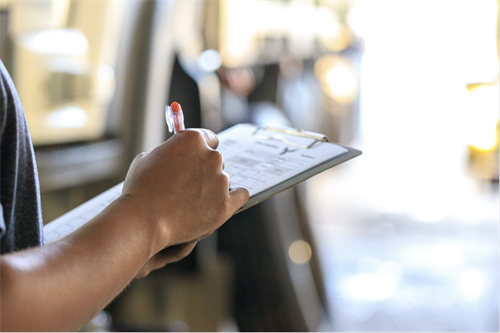
Pre-trip inspections for your driver and their vehicle
The pre-trip inspection is an important way for your drivers to begin their day. They take a little time, but the payoff can be huge. It’s up to you to set the standards for your company. Establish a specified step-by-step, walk around procedure and train all drivers to follow the guidelines you have established.
Each driver should have these items:
- Flashlight to see in dark or shaded areas
- Clean rag to wipe off light lenses and reflective tape
- Air gauge to check tire pressure
A good inspection should cover the four most important systems on the truck: tires, brakes, lights and steering.
- Check the vehicle’s general condition. Start about 20 feet away from the truck to view the entire truck. Check underneath for any puddles or pools of oil and other vehicle fluids. Also look for any visible damage to the truck and for anything that may be hanging or dragging underneath.
- Walk around the vehicle and inspect all major equipment items. During the walk-around, constantly look for any body and/or frame damage to the tractor, trailer and cargo.
- Check the condition of all tires and rims and use a tire gauge to check inflation. Tire thumpers do not identify improperly inflated tires.
- Check the brake system. Listen for air leaks. Confirm all brakes are in proper adjustment.
- Make sure all emergency devices are in the vehicle including a properly rated and maintained fire extinguisher and warning devices to use for emergency stops.
- Start the engine and check for any unusual smells and noises. Watch for fluid leaks as well.
- Check all gauges to make sure they are functioning properly.
- Activate horns to make sure they work properly.
- Inspect the steering system. Check for loose play and look for broken parts.
- Check mirrors for proper adjustment, cleanliness and securement.
- Activate windshield wipers to check for proper operation. Also, check for any worn or damaged wiper blades and that the windshield washer reservoir is full.
- Check all lights for proper operation, including headlights, taillights, brake lights, directional lights and warning lights.
- Check under the hood for worn belts, leaking fluids, cracked wires, etc.
If any issues are detected, make sure your drivers know who to inform. Proper maintenance and quick resolution of issues will save you time and money with fewer breakdowns.
Categorized in:
-
Regulations
-
Vehicle Inspections
-
Transportation Safety
ClickToAddCategories
No categories have been created yet.
Community
Company Updates
Driver Recruitment
Investor News
Transportation Safety
Claims
Driver Management
Driving Techniques
Distracted Driving
Seasonal Driving Tips
Sharing the Road
Health & Wellness
Injury Prevention
Regulations
Security & Cargo Theft
Vehicle Inspections
Weather Conditions
Workplace Safety
Workers Compensation
Done